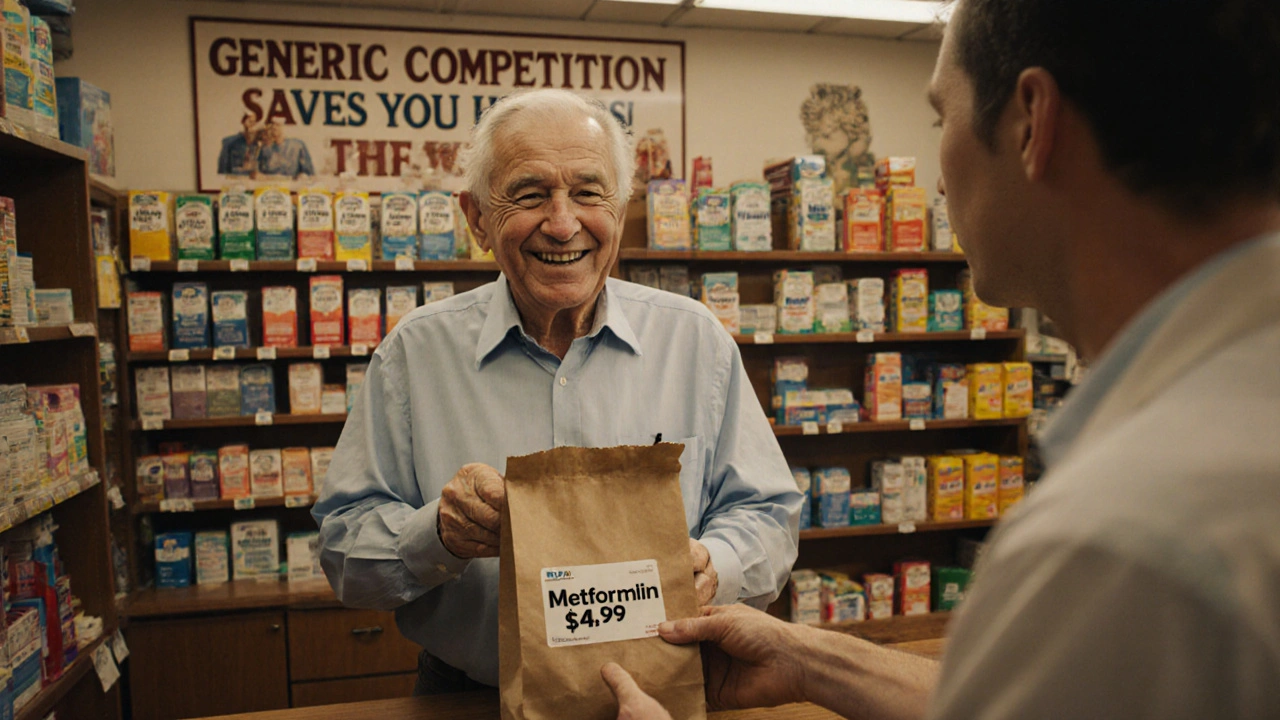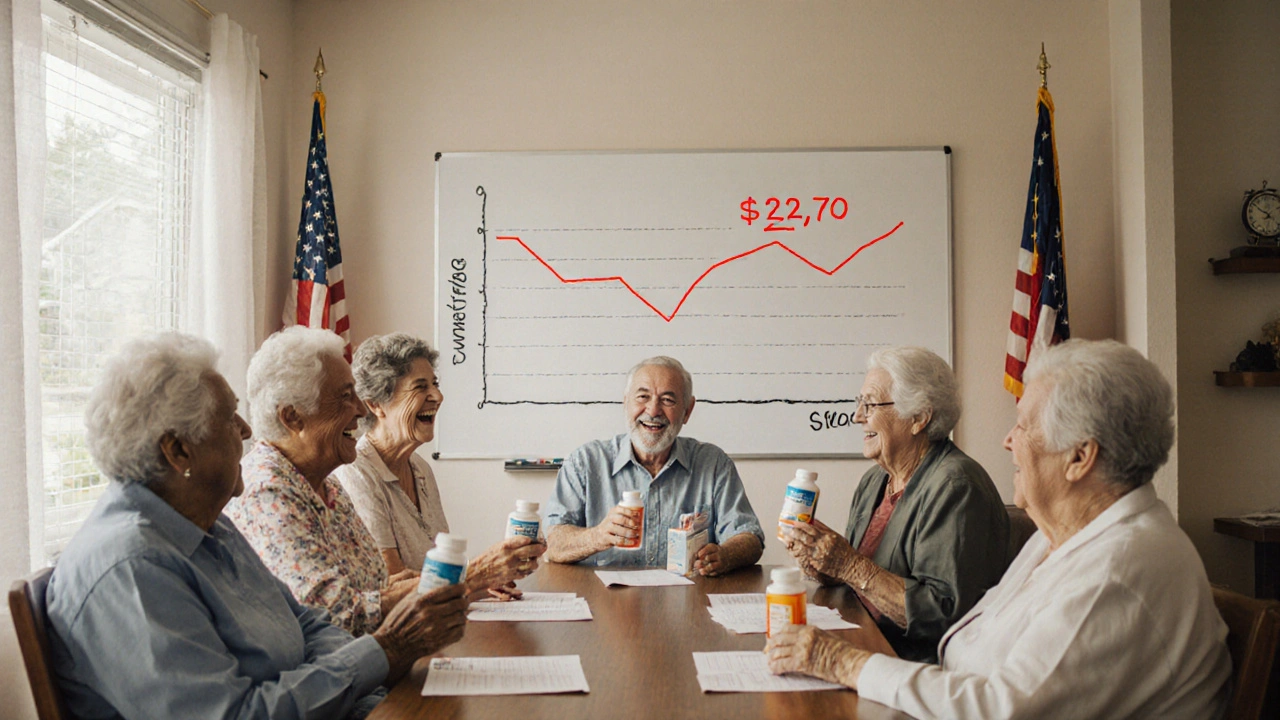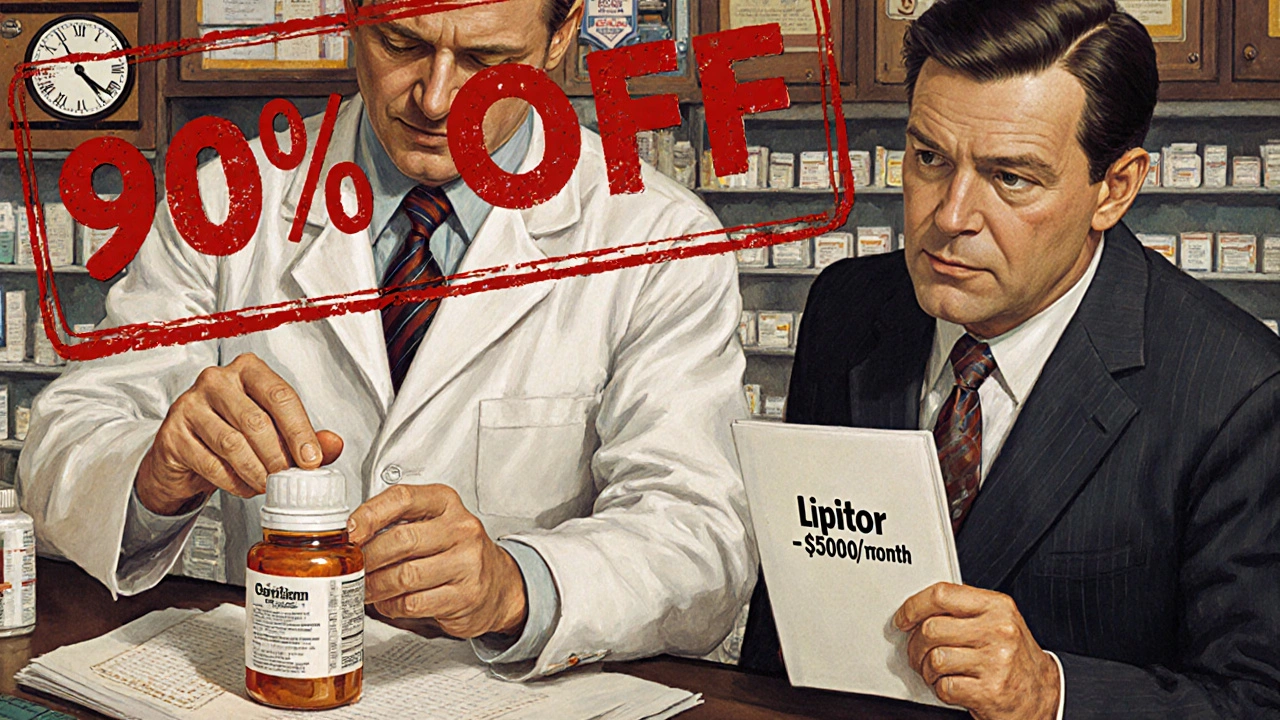How Buyers Use Generic Drug Competition to Lower Prescription Prices

When you fill a prescription for a common medication like metformin or lisinopril, you’re probably paying less than $5 for a 30-day supply. That’s not because the drug is cheap to make-it’s because generic drug competition has forced prices down by more than 90%. This isn’t luck. It’s the result of deliberate strategies by buyers-government programs, insurers, and pharmacy benefit managers-who use the threat or reality of multiple generic manufacturers to drive down costs. Understanding how this works can help you see why some drugs suddenly drop in price, and why others stay high even when generics are available.
How Generic Drugs Drive Prices Down
When a brand-name drug’s patent expires, any manufacturer can apply to make a generic version. The FDA approves these copies if they’re chemically identical and work the same way. The moment a second generic enters the market, prices start falling. With three or four competitors, prices often drop to 30-50% of the brand’s original cost. By the time six generics are available, the median price is just 9.9% of the brand price. With nine or more, it’s down to 2.7%.
This isn’t theoretical. In 2021, the FDA analyzed over 2,400 newly approved generics and found that each additional competitor cut prices by an average of 15-20%. For drugs like atorvastatin (Lipitor), which now has over 100 generic makers, the average price per pill is less than a penny. The same pattern shows up in other countries. In Canada, when a drug has three or more generics, the government automatically lowers its maximum allowable price. In Germany, pharmacies are required to dispense the cheapest generic unless a doctor specifies otherwise.
How Buyers Use Competition as a Negotiation Tool
Buyers don’t wait for prices to fall naturally-they actively use generic competition to pressure brand-name companies. The most powerful example is the U.S. Medicare Drug Price Negotiation Program, created by the 2022 Inflation Reduction Act. Medicare can now negotiate prices for 10 high-cost drugs each year. But here’s the key: they don’t negotiate based on what the brand charges. They look at what the cheapest generic alternatives cost.
CMS (Centers for Medicare & Medicaid Services) uses data from Prescription Drug Event records and Average Manufacturer Prices to identify the lowest prices for drugs in the same therapeutic class. If a brand drug has multiple generic competitors selling for $10 a month, CMS won’t offer the brand maker more than $15-even if the brand’s original price was $500. This forces brand manufacturers to either accept a much lower price or risk losing Medicare business entirely.
Even commercial insurers and pharmacy benefit managers (PBMs) use this tactic. Many have contracts that require manufacturers to offer the lowest price available to any buyer. If a generic is selling for $5, the brand must match it-or lose the contract. This creates a domino effect: even drugs without direct generic competition see price pressure because manufacturers know they’re competing against the entire generic market.
Why Some Drugs Still Cost Too Much
Not all drugs follow this pattern. Some brand-name drugs stay expensive for years after generics are available. Why? Because manufacturers use tactics to delay competition. One common trick is “product hopping”-slightly changing the drug’s form (like switching from a pill to an inhaler) and pushing patients to the new version, which still has patent protection. Between 2015 and 2020, there were over 1,200 of these maneuvers, according to the FTC.
Another tactic is “reverse payments.” A brand-name company pays a generic maker to delay entering the market. Between 2010 and 2020, over 100 such deals were made in the U.S., delaying generic entry by an average of two years. The FTC has challenged these, but they’re still happening. In some cases, brand companies even launch their own “authorized generics”-same drug, same maker, just sold under a different label at a lower price. This floods the market early, making it harder for independent generics to compete.
Complex drugs like biosimilars (generic versions of biologic drugs) don’t follow the same rules. They’re harder to make, take longer to approve, and face more patent barriers. As a result, they only capture about 45% of the market, compared to 90% for traditional generics. That’s why drugs like Humira still cost over $7,000 a month in the U.S., even though biosimilars have been available for years.

What Works: International Models
Other countries have built systems that make generic competition more effective. Canada’s tiered pricing system adjusts the maximum price a drug can be sold for based on how many generics are on the market. One generic? Higher price cap. Five generics? Much lower. It’s a simple rule that keeps prices falling as competition grows.
The UK uses reference pricing-setting a benchmark price based on what similar drugs cost in Germany, France, and other European countries. If a drug is cheaper elsewhere, the UK forces manufacturers to match it. This keeps prices aligned with global competition, not just local monopolies.
Germany’s system is even more direct: pharmacists must dispense the cheapest generic unless the doctor writes “do not substitute.” This gives patients the lowest possible price by default. The result? Germany gets 72% of prescriptions filled with generics, while the U.S. hits 90%. But because the U.S. doesn’t control prices the same way, the total spending on drugs is still far higher.
Who Benefits-and Who Loses
The biggest winners are patients and taxpayers. The Medicare program estimates that negotiating prices for the first 10 drugs will save beneficiaries $6.8 billion a year. The Association for Affordable Medicines says generics have saved U.S. patients over $3 trillion since 2000.
But the system isn’t perfect. Generic manufacturers say they’re being squeezed. If CMS sets a low price for a brand drug before generics enter, it becomes harder for new generic makers to justify the cost of developing and launching their version. Avalere Health found that some generic companies delay or cancel launches because they can’t make a profit against both the brand and a government-set price.
Brand-name drugmakers argue that low prices hurt innovation. They claim that without high profits, they can’t fund new research. But data shows most of their spending goes to marketing, not R&D. In 2023, U.S. drug companies spent $30 billion on advertising and $25 billion on research. Meanwhile, the U.S. government pays for over 60% of all drug spending through Medicare, Medicaid, and VA programs.

The Future: More Data, More Pressure
The next wave of change will come from better data. CMS now uses real-world evidence-like how well a drug works in actual patients-to adjust prices. By 2025, 73% of health agencies plan to use this data in negotiations. That means drugs that don’t perform better than generics will be priced lower, no matter how expensive they are to make.
Legislators are also reacting. The proposed EPIC Act would delay Medicare negotiations until after generic competition has had time to develop. That way, generics can enter the market at full strength before the government steps in. If passed, it could prevent the “chilling effect” where government pricing discourages new generic makers.
Meanwhile, the global generic market is growing fast-projected to hit $700 billion by 2030. More manufacturers are entering from India, China, and Southeast Asia. That means even more competition, lower prices, and more pressure on brand-name companies to justify their costs.
What This Means for You
If you’re paying for prescriptions, you’re already benefiting from generic competition. But you can do more. Ask your pharmacist: “Is there a generic version?” If your doctor prescribes a brand drug, ask: “Is there a cheaper alternative that works just as well?” Many times, the answer is yes.
And if you’re on Medicare or another government plan, know that your plan is actively using generic prices to negotiate lower costs. You don’t need to do anything extra-your savings are built into the system. But staying informed helps you understand why your bills change, and why some drugs still cost too much.
The bottom line? Generic competition isn’t just a market force-it’s a tool. And when buyers use it well, it saves billions. The challenge now is making sure that tool isn’t undermined by legal loopholes, delayed entries, or government policies that accidentally discourage the very competition that keeps prices low.
How do generic drugs actually lower prices?
When multiple manufacturers make the same generic drug, they compete on price. Each new entrant forces others to lower their prices to stay competitive. Studies show that with six generic competitors, prices drop to about 10% of the brand-name price. With nine or more, they fall to under 3%. This happens because manufacturers don’t need high margins when they’re selling in bulk to pharmacies and insurers.
Why do some brand-name drugs stay expensive even after generics are available?
Brand companies use tactics like product hopping (changing the drug’s form to extend patents), reverse payments (paying generics to delay entry), and authorized generics (launching their own low-priced version) to limit competition. These tactics delay or weaken the price-lowering effect of generics, keeping prices high longer than they should be.
Does Medicare negotiate drug prices directly with generic makers?
No. Medicare doesn’t negotiate with generic manufacturers directly. Instead, it uses the prices of existing generics as a benchmark to set the starting price for negotiating with brand-name drugmakers. The presence of low-cost generics gives Medicare leverage to push brand prices down, even if it’s not talking to the generic makers themselves.
Are all generic drugs the same as the brand?
Yes, by FDA standards. Generic drugs must contain the same active ingredient, dosage, strength, and route of administration as the brand. They must also be bioequivalent-meaning they work the same way in the body. Differences in inactive ingredients (like fillers) don’t affect effectiveness. Most doctors and pharmacists consider generics interchangeable with brand-name drugs.
What’s the difference between generics and biosimilars?
Generics are exact copies of small-molecule drugs made through chemical synthesis. Biosimilars are copies of complex biologic drugs made from living cells. Because biologics are much harder to replicate, biosimilars aren’t identical-they’re “similar.” They take longer to approve, cost more to make, and face more patent barriers. As a result, they only capture about 45% of the market, compared to 90% for traditional generics.
Can I ask my doctor to prescribe a generic drug?
Absolutely. In fact, it’s one of the easiest ways to save money. Most conditions can be treated with generics. Ask your doctor: “Is there a generic version available?” or “Would a generic work just as well?” Doctors are required to honor your request unless there’s a medical reason not to. Many do so automatically, but it never hurts to ask.
Erika Sta. Maria
November 21, 2025 AT 09:00soooooo... you're telling me that the reason my metformin costs $3 is because some guy in bangalore figured out how to spell 'c8h17n5o3s' correctly? lol. i mean, sure, it's great for me, but doesn't it feel like we're all just pawns in a game where the real winners are the 3 indian pharma CEOs who drive ferraris? i'm not mad, just... philosophically confused. also, typo: 'chemically identical' should be 'chemically idendical' 😘
Nikhil Purohit
November 21, 2025 AT 10:30That’s actually wild when you think about it. I used to pay $400 for my blood pressure med until a generic came out - now it’s $4. I didn’t even know generics were this powerful. It’s like the market finally woke up and said, ‘yo, we don’t need to pay for marketing fluff.’ Seriously, if you’re on a prescription, always ask for the generic. It’s not just cheaper - it’s the exact same thing. Pharmacists know this. Doctors know this. You just gotta speak up.